Abstract
A review of a 14-year experience with prophylactic pigmented skin lesion removal is presented. Data obtained during a 4-year interval of this 14-year experience is analyzed specifically. During this 4-year interval, 250 patients with melanoma were seen. Of these patients, 75 with a history of stage I (localized) melanoma and three patients with stage II (history of controlled regionally metastatic melanoma) underwent removal of multiple skin lesions on a prophylactic basis. Of the removed lesions, 28% showed hyperplasia, atypia, dysplasia, or melanoma. Nine unsuspected in situ, or level I melanomas, and three unsuspected invasive melanomas were removed from these 75 melanoma patients while excising lesions prophylactically during the 4-year interval. It is estimated that four to six additional melanomas were prevented by excision of precursor lesions. During the same 4-year interval, an additional 112 of approximately 1000 patients without a previous history of melanoma underwent prophylactic lesion removals. In 31% of the 112 patients, there was a history of melanoma in a first-degree relative. In 22% of the removed lesions there was hyperplasia, atypia, or dysplasia. Three cases of melanoma in situ were detected and it is estimated that an additional three to five cases of melanoma were prevented. Atypical findings occurred in 71, or 63%, of the patients biopsied, which represented 7% of the approximately 1000 patients screened. During the 4-year interval, an average of 17.7 lesions were removed from each of the 190 melanoma and nonmelanoma patients undergoing prophylactic skin lesion excision. This was accomplished in one to four sessions per patient. This average reflects only those patients who underwent one excision or more and does not include those patients treated without operation. When including the nonoperated patients screened during this interval, the average number of lesions removed was 2.7 per patient. Death from new melanomas was prevented during the 14-year period of this study as evidenced by the fact that no patient died or developed metastatic disease from a cutaneous melanoma that was not apparent or known about at the time of first examination.
Full text
PDF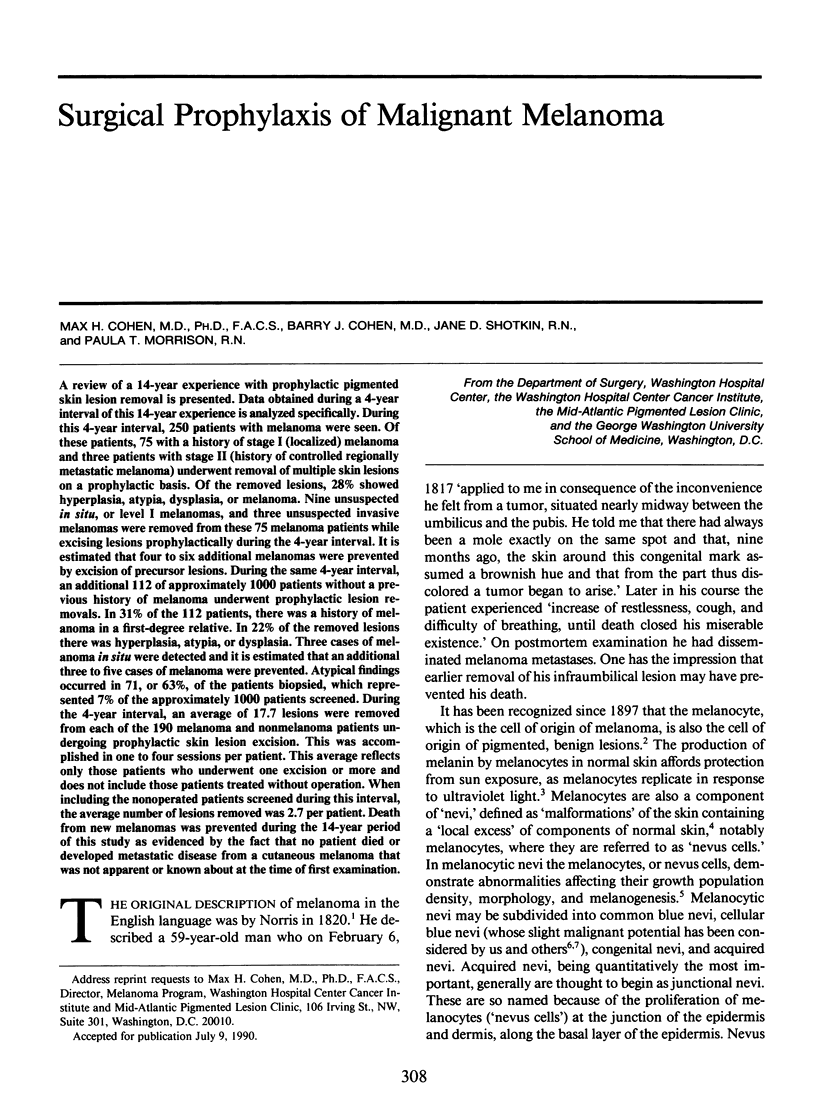
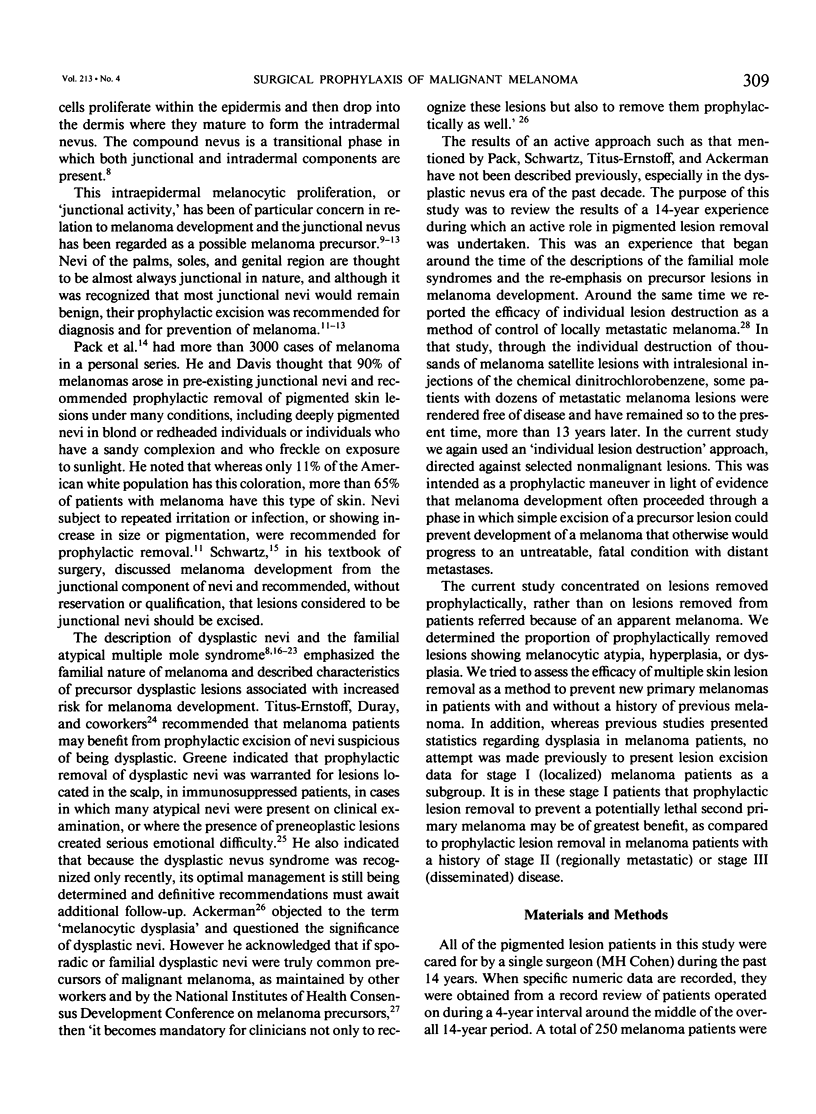
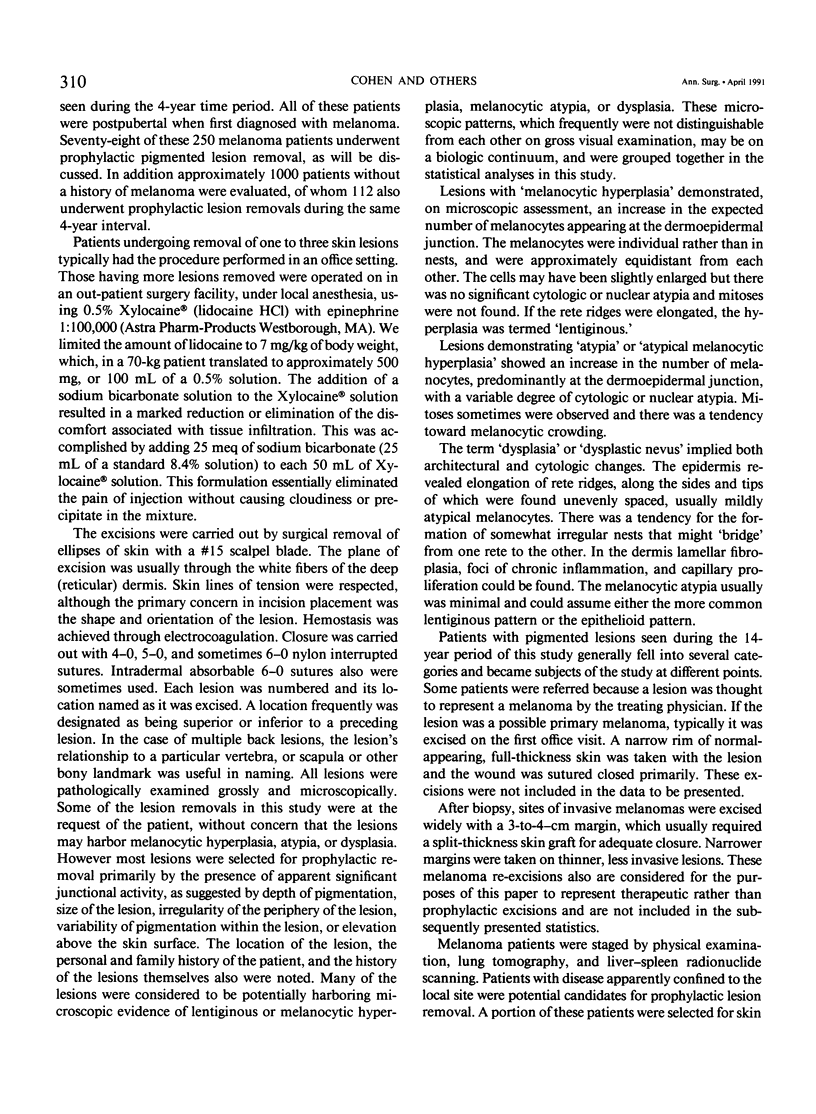
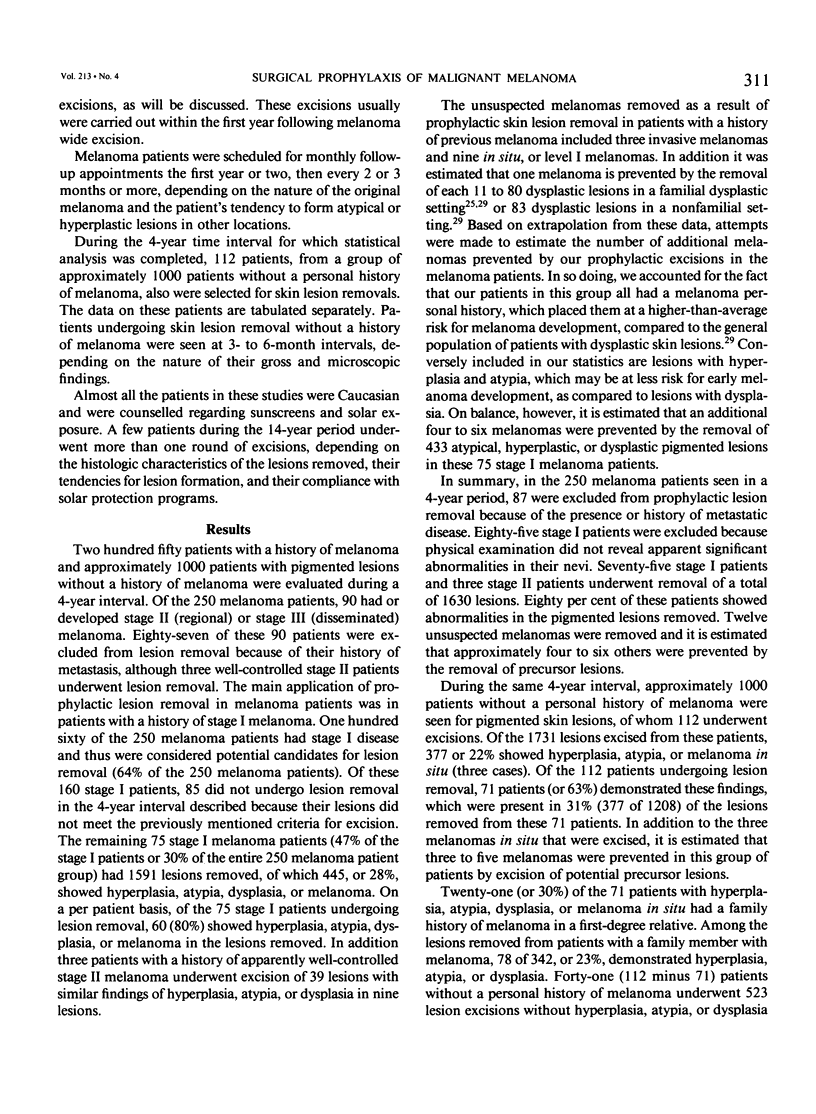
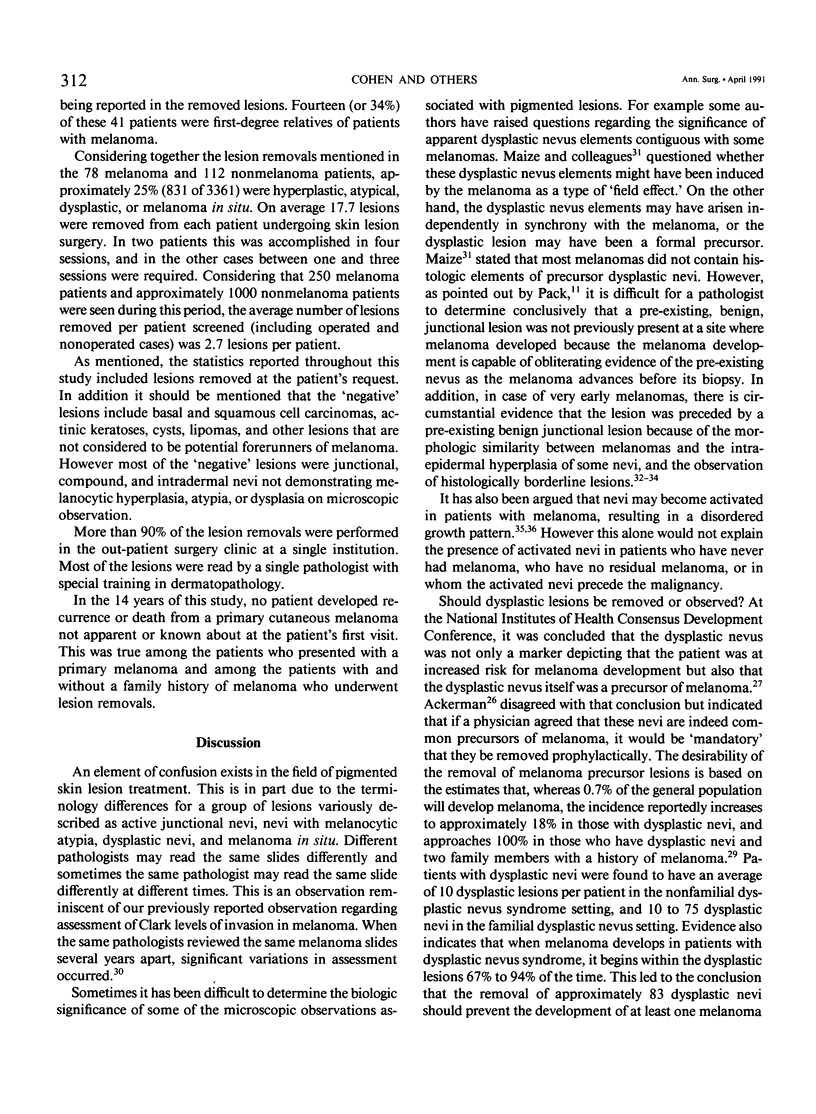
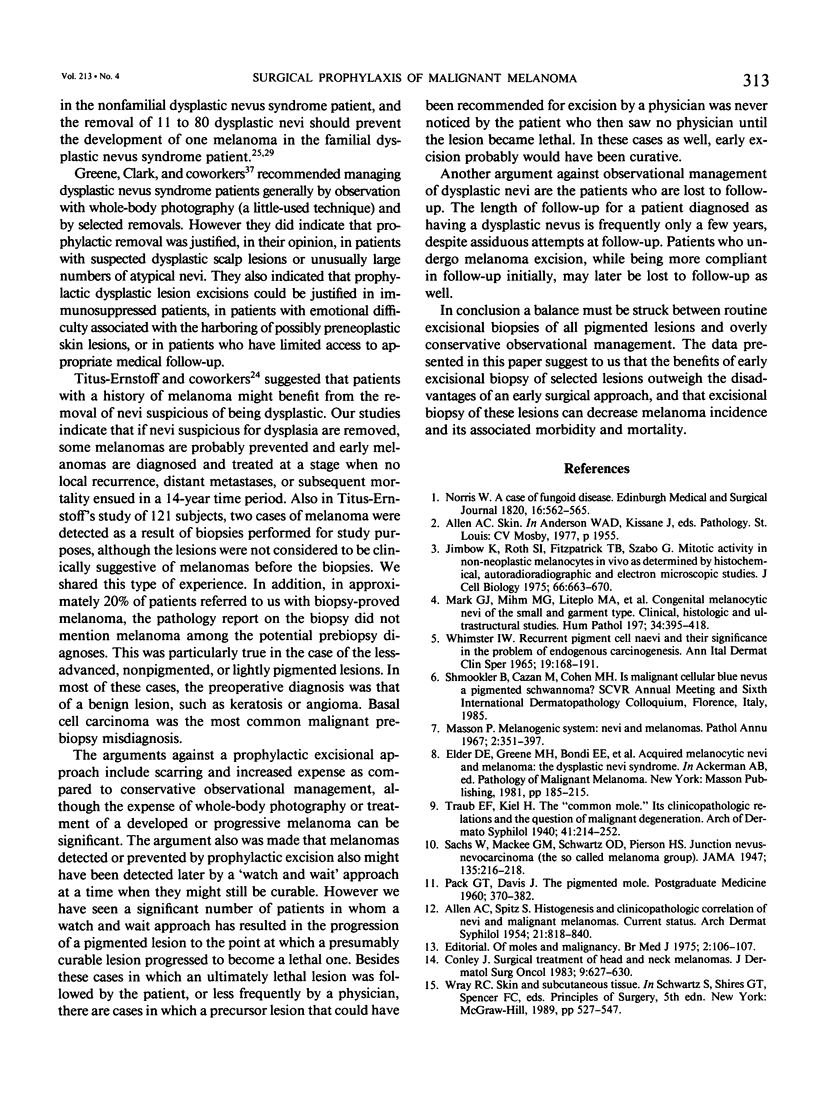
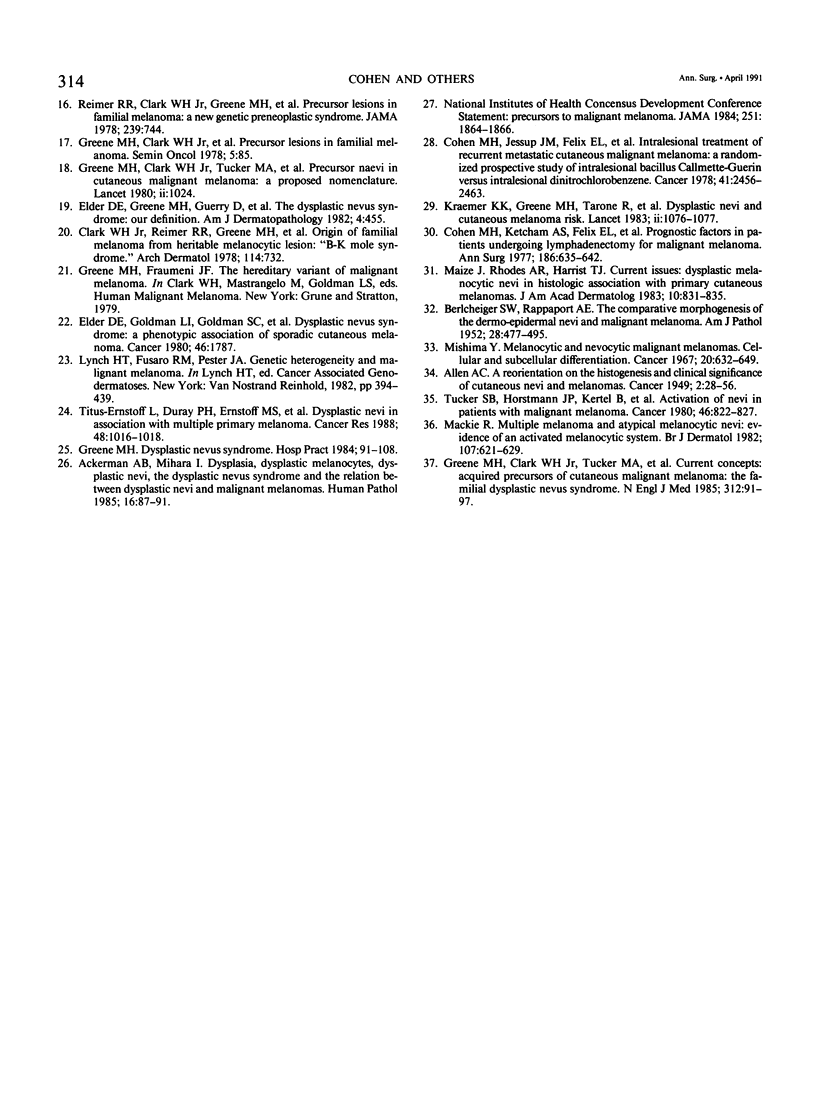
Selected References
These references are in PubMed. This may not be the complete list of references from this article.
- Ackerman A. B., Mihara I. Dysplasia, dysplastic melanocytes, dysplastic nevi, the dysplastic nevus syndrome, and the relation between dysplastic nevi and malignant melanomas. Hum Pathol. 1985 Jan;16(1):87–91. [PubMed] [Google Scholar]
- BERKHEISER S. W., RAPPOPORT A. E. The comparative morphogenesis of the dermo-epidermal nevi and malignant melanoma. Am J Pathol. 1952 May-Jun;28(3):477–495. [PMC free article] [PubMed] [Google Scholar]
- Clark W. H., Jr, Reimer R. R., Greene M., Ainsworth A. M., Mastrangelo M. J. Origin of familial malignant melanomas from heritable melanocytic lesions. 'The B-K mole syndrome'. Arch Dermatol. 1978 May;114(5):732–738. [PubMed] [Google Scholar]
- Cohen M. H., Jessup J. M., Felix E. L., Weese J. L., Herberman R. B. Intralesional treatment of recurrent metastatic cutaneous malignant melanoma: a randomized prospective study of intralesional Bacillus Calmette-Guerin versus intralesional dinitrochlorobenzene. Cancer. 1978 Jun;41(6):2456–2463. doi: 10.1002/1097-0142(197806)41:6<2456::aid-cncr2820410654>3.0.co;2-b. [DOI] [PubMed] [Google Scholar]
- Cohen M. H., Ketcham A. S., Felix E. L., Li S. H., Tomaszewski M. M., Costa J., Rabson A. S., Simon R. M., Rosenberg S. A. Prognostic factors in patients undergoing lymphadenectomy for malignant melanoma. Ann Surg. 1977 Nov;186(5):635–642. doi: 10.1097/00000658-197711000-00016. [DOI] [PMC free article] [PubMed] [Google Scholar]
- Conley J. Surgical treatment of head and neck melanomas. J Dermatol Surg Oncol. 1983 Aug;9(8):627–630. doi: 10.1111/j.1524-4725.1983.tb00870.x. [DOI] [PubMed] [Google Scholar]
- Elder D. E., Goldman L. I., Goldman S. C., Greene M. H., Clark W. H., Jr Dysplastic nevus syndrome: a phenotypic association of sporadic cutaneous melanoma. Cancer. 1980 Oct 15;46(8):1787–1794. doi: 10.1002/1097-0142(19801015)46:8<1787::aid-cncr2820460816>3.0.co;2-s. [DOI] [PubMed] [Google Scholar]
- Greene M. H., Clark W. H., Jr, Tucker M. A., Elder D. E., Kraemer K. H., Fraser M. C., Bondi E. E., Guerry D., Tuthill R., Hamilton R. Precursor naevi in cutaneous malignant melanoma: a proposed nomenclature. Lancet. 1980 Nov 8;2(8202):1024–1024. doi: 10.1016/s0140-6736(80)92176-5. [DOI] [PubMed] [Google Scholar]
- Greene M. H., Clark W. H., Jr, Tucker M. A., Elder D. E., Kraemer K. H., Guerry D., 4th, Witmer W. K., Thompson J., Matozzo I., Fraser M. C. Acquired precursors of cutaneous malignant melanoma. The familial dysplastic nevus syndrome. N Engl J Med. 1985 Jan 10;312(2):91–97. doi: 10.1056/NEJM198501103120205. [DOI] [PubMed] [Google Scholar]
- Greene M. H. Dysplastic nevus syndrome. Hosp Pract (Off Ed) 1984 Jan;19(1):91-103, 107-8. doi: 10.1080/21548331.1984.11702727. [DOI] [PubMed] [Google Scholar]
- Greene M. H., Reimer R. R., Clark W. H., Jr, Mastrangelo M. J. Precursor lesions in familial melanoma. Semin Oncol. 1978 Mar;5(1):85–87. [PubMed] [Google Scholar]
- Jimbow K., Roth S. I., Fitzpatrick T. B., Szabo G. Mitotic activity in non-neoplastic melanocytes in vivo as determined by histochemical, autoradiographic, and electron microscope studies. J Cell Biol. 1975 Sep;66(3):663–670. doi: 10.1083/jcb.66.3.663. [DOI] [PMC free article] [PubMed] [Google Scholar]
- Kraemer K. H., Greene M. H., Tarone R., Elder D. E., Clark W. H., Jr, Guerry D., 4th Dysplastic naevi and cutaneous melanoma risk. Lancet. 1983 Nov 5;2(8358):1076–1077. doi: 10.1016/s0140-6736(83)91055-3. [DOI] [PubMed] [Google Scholar]
- MacKie R. M. Multiple melanoma and atypical melanocytic naevi--evidence of an activated and expanded melanocytic system. Br J Dermatol. 1982 Dec;107(6):621–629. doi: 10.1111/j.1365-2133.1982.tb00519.x. [DOI] [PubMed] [Google Scholar]
- Maize J. C. Dysplastic melanocytic nevi in histologic association with primary cutaneous melanomas. J Am Acad Dermatol. 1984 May;10(5 Pt 1):831–835. doi: 10.1016/s0190-9622(84)80130-9. [DOI] [PubMed] [Google Scholar]
- Merkel C., Cagol P. P., Da Pian P. P., Bolognesi M., Sacerdoti D., Gatta A. Blood flow of experimental liver metastases in rat as evaluated by the locally injected 133-Xenon washout. Res Exp Med (Berl) 1985;185(3):207–215. doi: 10.1007/BF01852034. [DOI] [PubMed] [Google Scholar]
- Mishima Y. Melanocytic and nevocytic malignant melanomas. Cellular and subcellular differentiation. Cancer. 1967 May;20(5):632–649. doi: 10.1002/1097-0142(1967)20:5<632::aid-cncr2820200510>3.0.co;2-7. [DOI] [PubMed] [Google Scholar]
- PACK G. T., DAVIS J. The pigmented mole. Postgrad Med. 1960 Mar;27:370–382. doi: 10.1080/00325481.1960.11712849. [DOI] [PubMed] [Google Scholar]
- Reimer R. R., Clark W. H., Jr, Greene M. H., Ainsworth A. M., Fraumeni J. F., Jr Precursor lesions in familial melanoma. A new genetic preneoplastic syndrome. JAMA. 1978 Feb 20;239(8):744–746. [PubMed] [Google Scholar]
- Titus-Ernstoff L., Duray P. H., Ernstoff M. S., Barnhill R. L., Horn P. L., Kirkwood J. M. Dysplastic nevi in association with multiple primary melanoma. Cancer Res. 1988 Feb 15;48(4):1016–1018. [PubMed] [Google Scholar]
- Tucker S. B., Horstmann J. P., Hertel B., Aranha G., Rosai J. Activation of nevi in patients with malignant melanoma. Cancer. 1980 Aug 15;46(4):822–827. doi: 10.1002/1097-0142(19800815)46:4<822::aid-cncr2820460430>3.0.co;2-p. [DOI] [PubMed] [Google Scholar]


